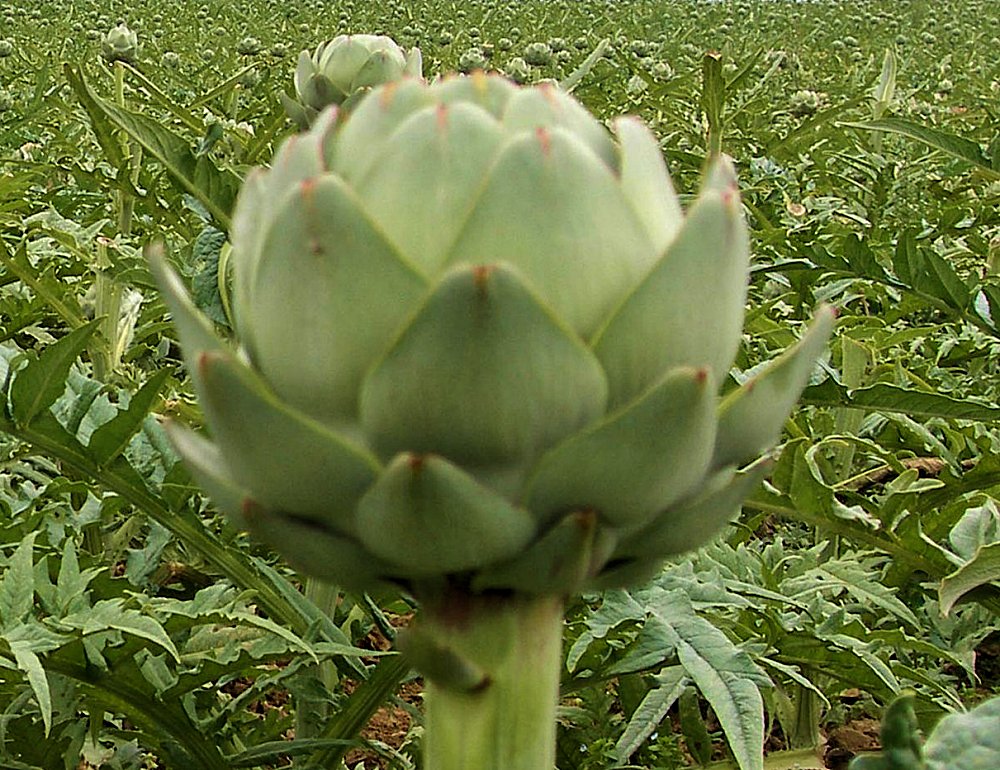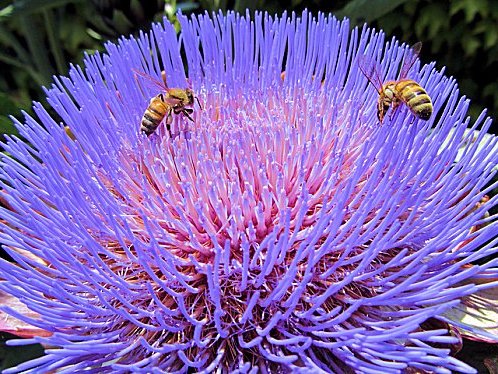

Arizona Vegetable & Fruit Gardening For The Arizona Desert Environment.
Pictures, Photos, Images
Descriptions, Information, & Reviews.
Cynara cardunculus var. scolymus
 |
| Globe Artichoke, Cynara cardunculus var. scolymus. Photo Courtesy Of Wikipedia, the free encyclopedia. |
|---|
 |  |
| Globe Artichoke Flower & Bees. Cynara cardunculus var. scolymus. | Globe Artichoke. Being Cooked. Cynara cardunculus var. scolymus. Photo Courtesy Of Wikipedia, the free encyclopedia. |
|---|
Globe Or Imperial Star Artichoke.
We wish to thank Wikipedia, the free encyclopedia for some of the information on this page. We share information, and donate to Wikipedia. The globe artichoke (Cynara cardunculus var. scolymus) is a variety of a species of thistle which is cultivated as a food. The edible portion of the plant consists of the flower buds before the flowers come into bloom. The budding artichoke flower-head is a cluster of many budding small flowers (called an inflorescence) together with many bracts, on an edible base. Once the buds bloom the structure changes to a coarse, barely edible form. Another variety of the species is the cardoon. It is a perennial plant native to the Mediterranean region. Both wild forms and cultivated varieties (cultivars) exist. This vegetable grows well at several elevations in Arizona. HISTORY OF ARTICHOKES: The cardoon (Cynara cardunculus), which is native to the Mediterranean area, is the naturally occurring variant of the artichokes. It was used as a food among the ancient Greeks and Romans. In North Africa, seeds of artichokes, probably cultivated, were found during the excavation of the Roman-period Mons Claudianus in Egypt. Varieties of artichokes have been cultivated in Sicily, since the classical period of the ancient Greeks, the Greeks called them kaktos. From the Greek cultivation, they improved in quality from the former wild form of the plant. The Romans called artichokes (carduus) (therefore, the name cardoon). Globe artichokes are known to have been cultivated in Naples, Italy; around the middle of the 9th century. Further improvement in the cultivation of artichokes occured during the medieval period in Muslim Spain and the Maghreb. The various names for the artichoke in many of the European languages today come from the medieval Arabic word, al-khurshuf by the way of the late medieval Spainish Period (where it is nowadays called alcachofa). In his book, Les Paysans de Languedoc, Le Roy Ladurie, has documented the spread of artichoke cultivation in Italy and into southern France during the late 15th and early 16th centuries. It is said that carried by Filippo Strozzi, the blossom of the thistle, improved by the Arabs, passed from Naples to Florence in 1466. In about 1480 it is mentioned in Venice, & very soon it spreads towards the northwest of Italy. Artichoke beds are then mentioned in Avignon, by the notaries from 1532 onward; then spreading from the principle towns they spread into the hinterlands. They are mentioned as appearing as carchofas at Cavaillon in 1541, at Chateauneuf du Pape in 1553, at Orange in 1554. The local name remains carchofas, from the Italian word carciofo. Carchofas are very small, about the size of a hen's egg. Artichokes were introduced to England by the Dutch, where they were grown in Henry VIII's garden at Newhall in 1530. They were brought to the United States in the 19th century, to Louisiana by the French immigrants and later on to California by the Spanish immigrants. Thomas Jefferson reportedly raised artichokes at Monticello, his Virginia home, as early as 1767. It is stated in the diaries of George Washington that in about 1796 he raised Jerusalem artichoke. Today, the globe artichoke seems to be the most popular in cultivation and is concentrated in the countries bordering the Mediterranean basin. The main European producers are Italy, Spain, and France. In the United States, California provides nearly 100% of the U.S. crop, and about 80% of that is grown in Monterey County; there, Castroville proclaims itself to be "The Artichoke Center of the World", and holds the annual Castroville Artichoke Festival. This general area is along the coastal sections of Central California, where the weather suits them perfectly. Most recently, artichokes have been grown in South Africa in a small town called Parys located along the Vaal River. Commercial culture is limited to warm areas in USDA hardiness zone 7 and above. It is claimed that there are artichoke varities created for more northern climates, but they seem to be performing very poorly.
Artichoke plants thrive best where mild winters and cool, foggy summers prevail. Well, that's not Arizona! Since we are discussing the growing of artichokes in Arizona. We would like to mention that artichokes grow very well in several elevations in Arizona. We know of one farmer in the "Valley Of The Sun," who does very well growing artichokes as his main cash crop. While the Globe Artichoke does very well in Arizona, recently introduced seed cultivar 'Imperial Star' has been bred to produce in the first year and is better suited for Arizona's Climate. We grow both in Phoenix, and in Yarnell, Arizona. Yarnell is at about 4,864 feet elevation and sometimes freezes to about 15 degrees F. Artichokes can be produced from seeds or from vegetative means such as division, root cuttings or micropropagation. We usually use plants that we purchase from nurseries. But, rooted suckers can be planted each year. This way your old mature specimens can be disposed of after a few years, since each individual plant produces well for only a few years. In Arizona in zones 8 and 9 where several other plants are not normally winter-hardy; artichoke can be grown from seed as annuals, producing a limited harvest at the end of the first growing season. However, artichokes are technically perennials that normally produce the edible flower only during the second, and subsequent years. We treat ours in Yarnell, at 4,864 feet as perennials, but some produce the first year, and all produce the second, and subsequent years. While they can produce for up to about 15 years, we replant our artichokes about every 5 years. If your planting area has only a few frosty nights, your artichokes will usually overwinter when pruned, and mulched (zones 8 and 9). In colder regions, you have to treat artichokes as annuals planting them in the spring. In Arizona's frost-free areas of zones 10 and 11, artichokes do best when first planted in the fall. If you have the occasional frost in these zones, protect your plants by covering them during the evening and early morning, when frost is predicted.. Since artichoke buds usually flower in warmer weather, the peak season for artichoke harvesting in Arizona is in the late spring, but they can continue to be harvested throughout the summer, with another peak period in mid-autumn.
Propogation From Seed: If you are going to plant artichoke seeds, use a "seed-starter mix" (usually contains equal amounts of sifted loam, sand and leaf mold to make a good mixture) rather than regular potting soil. Start the seeds indoors, about 6 weeks before the frost-free date at a 75- to 80-degree temperature. Water the soil thoroughly with a fine spray and plant the seeds; they should be covered with about �-inch of soil. Once the first true leaves appear, they should be placed in at spot where the night temperature reaches between 50 to 55 degrees. Your daytime temperature should range from room temperature to 80 degrees. Remember cool nights prevent the plants from becoming lanky. Don�t over water your plants while they are young and maintain strong source of light either from either the sun or from fluorescent lights placed about 2 inches above the plants. After 3 weeks of growth, you can set your plants where the night temperature reaches about 40 When the outside temperature is safe, they may be placed into the garden and taken care of as described in the regular gardening section.
WHERE & HOW TO PLANT: Considering that your artichoke plants will be in place for up to 5 years. Select a site with partial shade to full sun and with well-drained soil. It should be tilled deeply before they are planted. It would be profitable if the soil was enriched with compost, leaf mold, peat moss or commercial humus. Manure should be used, if at all, with caution. The soil pH should be 6.0 to 7.0 and this can be maintained with dolomitic limestone, which ensures adequate calcium and magnesium. Soil that has a pH of 7.0 or higher may benefit from applications of agricultural sulfur. The ground should always be kept free of weeds by mulching or raking the ground about an inch deep after the plants are well established. Set plants out after danger from frost has passed and plant them a bit deeper than what they were growing in their containers. Space the plants about 4� feet apart, in rows 4� feet apart. Prepare the garden bed by using a garden fork or tiller to loosen the soil to a depth of 12 to 15 inches, then mix in a 2- to 4-inch layer of compost. Care. Keep planting beds weed free; cultivate shallowly to avoid disturbing roots. If you are expecting cold weather, cover your artichokes when frost is expected. When the young plants are exposed to cold, but protected from frost, they are "vernalized". This treatment can increase the quality and quantity of stem and eventually bud production, especially early in the season. After artichokes are established and unfurling new growth, fertilize your plants once a month with a liquid fertilizer such as Bonnie Herb & Vegetable Plant Food. Keep soil moist throughout the growing season. You can apply a liquid high-potassium fertilizer (often called a potash fertilizer) every 2 weeks during periods of active growth to encourage flower buds to form. The size of your artichoke harvest will increase with the age of your plants. So, you should try to overwinter your plants. For zones 6 and 7: Cut plants back to roughly 12 inches tall. Mound organic mulch over the plants, then cover plants and mulch with an inverted bushel basket. Feel free to use compost as this first mulch layer. Add a layer of mulch (straw is great at this point) over and around the bushel basket. Drape a rainproof cover over the mound, taking care to anchor the edges. For zones 8 and warmer: Following fall harvest, cut plants back to ground level or slightly below ground level. Cover with 3 to 4 inches of an organic mulch such as straw or shredded leaves. In the spring, after the ground is no longer frozen, and before growth begins, remove the winter covering. When new growth begins, fertilize plants again with Bonnie Herb & Vegetable Plant Food and add a 1-inch layer of compost or well-rotted manure around the plant. PESTS: Cultural practices are helpful in avoiding many insect infestations. Artichokes should be planted in well-prepared, fertile beds, mulched and properly watered to promote vigorous growth. Stressed plants tend to attract more insect pests than healthy plants. In a home garden, handpicking and destroying many pests is an effective control measure. In addition, beneficial insects are very helpful in controlling insects such as aphids, leafminers and hornworms. To avoid killing these beneficials, use insecticides only when necessary. Artichokes seem to be pretty much immune to most insects except for aphids, mites, scab, and thrips; which can also transmit other diseases. Also watch for leafhoppers, many forms of moth, cutworms, armyworms and any other larvae. Do not let slow snails and slugs crawl on you plants either.. Pyrethrin is a natural product for the control of aphids and caterpillars. Neem oil extract and insecticidal soap are less toxic options for control of aphids and whiteflies. Adequate coverage of upper and lower leaf surfaces with these insecticides is important for good pest control. Aphids can also be controlled with bifenthrin, cyhalothrin, or malathion. We personally use Talstar Pro 3/4 Gal Multi Use Insecticide / Termiticide / 7.9% Bifenthrin, and find it to be the best in both its ability to control pests and its cost. It also controls scorpions, which can be a real problem in Arizona. There is a link to it at Amazon, near the bottom of our page. DISEASES: Powdery mildew and botrytis blight can be a problem. Bacillus subtilis, & Basic Copper Sulfate can control these diseases. We recommend Bayer Advanced 708480 Serenade Garden Disease Control Concentrate, 32-Ounce. HARVEST: Here is that moment you have been waiting for! Note: Artichoke buds that are opening on the plant will not be as tender as artichokes harvested when the bud is not open. If buds are left to open on the plant, they can�t be eaten but they do make beautiful flowers in the garden. Flower buds form in early summer atop the tall stems that rise out of the center of the plant. Each stem forms several flower buds, with the top bud ripening first. Harvest buds while they�re tight and firm and at least 3 inches in diameter; if buds begin to open, they lose their tenderness. Fully open buds are inedible but produce striking, large, lavender flowers. Cut a 1- to 3-inch section of stem with each bud to make it easier to handle. The lower buds that develop later won�t grow as large as the top bud. When you have harvested all buds on a stem, cut the stem to the ground. For large, established plants, prune the entire plant back by a third to spur a fall harvest. Utah State University Cooperative Extension states that artichokes are ready for harvest by late July or early August up until the first frost. Perennial artichokes can actually be harvested all year long but the largest crops are produced in the spring. After the first years harvest, you can prune the stalk back about an inch or so below the ground to encourage new shoots to develop for a second harvest later in the year. Artichokes keep in the refrigerator for up to 2 weeks. As we mentioned earlier, another variety that has become very popular in our Arizona Climate is Imperial Star Artichoke. Suggestions as to how to grow Imperial Star Artichoke follow: Select a planting site that is in full sun and has well-drained soil and lots of organic matter. Moist soil that is heavily amended with compost and other humus will have the right acidity level. Set transplants, offsets and juvenile plants out after the soil temperature is 50 degrees F. or higher, and the danger of frost is past. Make sure the soil is loosened to at least 12 inches in depth, so tap roots can be positioned straight down. Space plants widely, since they will eventually grow to 5 feet in height and more than 40 inches in width.
If the climate is hot, mulch plants thickly to keep the soil cool. If soil temps exceed 85 degrees F. plants will go into Summer dormancy and they will not produce buds (from Mother Earth News).
The author of this web page is also a beekeeper. So George also wants to give you this advice about artichokes. To attract honey bees to your garden, it's a good idea to let some of your artichoke plants flower. Yes, you could pick them for your own dinner, but you'd be depriving the honey bees of theirs. If you attract the bees to your garden, they will pollinate other crops, such as melons; which require pollination by bees to produce fruit. But, while it is good to let your artichokes flower, don't them to go to seed. They tend to revert back to their wild form and become invasive in some areas (Hickman 1993). When grown from seed they often revert to a wild form, producing the inch-long spines around the flowerhead normally found on C. cardunculus (Thomsen et al. 1986). A well-tended artichoke plant can last and produce for as long as about 15 years, provided the grower divides and thins the root stock every three to four years to prevent the offshoots from overcrowding the plants and diminishing productivity. We recommend though; that when your plants begin to weaken from constant regrowing, which is about every five to ten years, you should clear out your old stock, and completely replant new artichokes in your garden.
Type: Classed as a vegetable.
Zones: USDA 7 - 11.
Height: 4.6 to 6.6 feet tall.
Spread: About 3- 4 feet wide.
Flowers: The flowers develop in a large head from an edible bud about 3.1�5.9 inches in diameter with numerous triangular scales; the individual florets are purple. The edible portions of the buds consist primarily of the fleshy lower portions of the involucral bracts and the base, known as the "heart"; the mass of immature florets in the center of the bud is called the "choke" or beard. These are inedible in older, larger flowers.
Blooming Time: Mid-summer to mid-fall. TO EAT: CUT FLOWER BUDS BEFORE THEY BLOOM!
Seeds: For propagation, the seeds need to come from a mature plant. Collect seedhead/pod when flowers fade; allow to dry. Allow seedheads to dry on plants; remove and collect seeds. Properly cleaned, seed can be successfully stored.
Leaves: Arching, deeply lobed, silvery, glaucous-green leaves 20�32 inches long.
Elevation: 0 - 5,000 feet.
Light: Full Sun.
Habitat: Rich well-drained, deep sandy loam soil with a 6.1 to 6.5 (mildly acidic) pH.
Native: The Mediterranean Region.
Propagation Methods: From seed; direct sow outdoors in fall; winter sow in vented containers, coldframe or unheated greenhouse; stratify if sowing indoors; sow indoors before last frost.
Miscellaneous: Photos Taken June 25, 2011 In Yarnell, Arizona. Hardy Temp: 15�F. May become a noxious weed or invasive. Average Water Needs; Water regularly; do not overwater. Self-sows freely; deadhead if you do not want volunteer seedlings next season. This plant is resistant to deer.
|
 /
/

We Are Proud Of Our SafeSurf Rating!
Click On The Item For A More Detailed Look. No Obligation!
|
|
|---|
| Back To Arizona Vegetable & Fruit Gardening
|
| Back To Arizona Xeriscape Landscaping Main Page
|
| To Arizona Wild Flowers Home Page
|
| Back To DeLange Home Page
Images And Text Copyright Eve & George DeLange.
|

